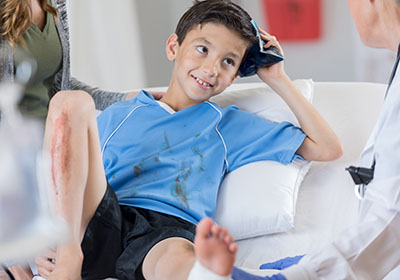
Author: Julie Kiefer, U of U Health Public Affairs
 University of Utah will provide data coordination and statistical support to a UCLA-led project that will study biomarkers that predict delayed recovery in children and teens
University of Utah will provide data coordination and statistical support to a UCLA-led project that will study biomarkers that predict delayed recovery in children and teens
The National Institute of Neurological Disorders and Stroke has awarded a $10-million grant to the Four Corners Youth Consortium, a group of academic medical centers studying concussions in school-aged children. Led by the UCLA Steve Tisch BrainSPORT Program, the project is named Concussion Assessment, Research and Education for Kids, or CARE4Kids. The University of Utah will lead data coordination and provide statistical support for the project.
Researchers will use advanced brain imaging and blood tests to explore biological markers—changes in blood pressure, heart rate and pupil reactivity—that may predict which children and adolescents will develop persistent symptoms following a concussion. The five-year CARE4Kids study will enroll more than 1,300 children nationwide.
Every year, more than 3 million Americans are diagnosed with concussions. Symptoms continue to plague 30 percent of patients three months after injury—adolescents face an even higher risk of delayed recovery. Chronic migraine headaches, learning and memory problems, exercise intolerance, sleep disturbances, anxiety and depressed mood are common.
“We are excited to launch this innovative investigation into concussions, which remain a serious public health concern for our nation’s youth and their families,” explained Christopher Giza, M.D., director of the UCLA Steve Tisch BrainSport Program and a professor of neurosurgery and pediatrics at UCLA’s David Geffen School of Medicine and Mattel Children’s Hospital. “Using objective tests to accurately predict recovery can lead to earlier, more effective interventions and serve as a foundation for innovative new treatments.”
The grant was announced on Sept. 9.
The study will unfold in two phases. The first part will evaluate children with concussion to identify a set of biomarkers predictive of persistent post-concussion symptoms. To validate the findings, the next stage will confirm that these biomarkers accurately predict prolonged symptoms in a second group of children who have been diagnosed with concussion. The goal is to develop a practical algorithm for application in general clinical practice for doctors and other health professionals caring for pediatric patients.
Giza will lead the multi-site study with Frederick Rivara, M.D., at Seattle Children’s Hospital and Gerard Gioia, M.D., at Children’s National in Washington, DC.
“We will be gathering innovative data to help answer the critical question asked by every patient: ‘When can I expect to recover from this concussion?’” said Gioia. “We have a great team and are excited to have been selected to study this important issue.”
Institutions currently recruiting patients for the study include UCLA Mattel Children’s Hospital, Children’s National Hospital, Seattle Children’s, the University of Washington, University of Rochester, University of Texas Southwestern Medical Center and Wake Forest School of Medicine. Indiana University, the National Institute of Nursing Research, University of Arkansas and University of Southern California. The University of Utah’s Pediatric Critical Care Medicine’s Data Coordinating Center and TBI and Concussion Center are also involved in the project.
Lawrence Cook, M.D., Professor of Pediatrics, will be the the principal investigator at the University of Utah.
"The Department of Pediatrics has created a nationally known resource for designing, managing, and analyzing multi-site studies. We are honored to be a part of this effort to improve treatment of concussions and get kids back to their normal activities,” said Cook.
Earlier research that led to this project was funded by private donations from Stan and Patti Silver, the UCLA Steve Tisch BrainSPORT Program and the UCLA Easton Clinic for Brain Health; as well as from the Satterberg Foundation to Seattle Children’s Research Institute; and an investment from the Sports Institute at UW Medicine.
###